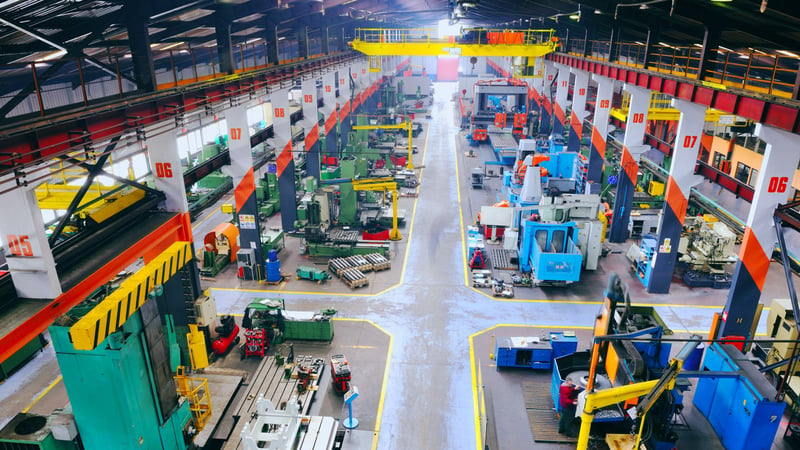Exploring the key scenarios where moving a piece of manufacturing equipment is necessary, with Paul Haenchen, Senior Solutions Manager at NavVis.
Factory layout design is not set in stone. Things change, and occasionally an established process or layout will inevitably have to be altered. However, machine tools on many production processes tend to be large and heavy, and connected to multiple services and IT systems. Therefore, moving them tends to be a last resort and a rare occurrence.
According to Paul Haenchen, Senior Solutions Manager, Digital Factory, at NavVis, there are two main scenarios where moving a piece of manufacturing equipment are necessary.
The most common occurs when a company wants to implement a new product on an existing production line, or when an entire manufacturing process has to be changed to accommodate new product specifications.
“When we look at a factory itself," he says, "everything is related to the product that is made there. If there is a change in the product, this can change the manufacturing line.”
If there is no change in product specifications, the main reason for moving equipment is to optimise or modernise an existing process. This, Haenchen said, is not so common.
“I was involved in a project where it was happening just because the factory was really old,” he explained. “I think this is not such a common case, because when you are earning money by producing something, and everything is running, there must be a really good reason to shut everything down and modernise it.”
Such reasons, he continues, might include developing a better process based on automation, faster operations based on a robotic solution, or implementation of healthier, more comfortable ergonomics for the operator. A balance is sought between minimizing disruptions to current systems while also bringing in long-term improvements.
When a mature process is in operation, product -related reasons for moving equipment might include the product needing more space, or a legal reason for implementing changes, such as the need for new control systems to improve health and safety.

Decisions to make before equipment relocation
When considering an equipment move, companies will have to make a sequence of decisions. The first, perhaps obviously, is to decide what the change should be, and which equipment is going to moved.
The equipment should then be categorised according to how difficult they are to move. Category A equipment – easy to move – might include such tools as cordless electric screwdrivers. Category B would then be semi-automated assembly or machining stations. Category C – the hardest to move – would be very large fully automated machines.
“Semi-automated devices might have wheels,” Haenchen commented. “But for the very large fully automated machines, you might need to bring in forklifts and that would entail greater planning requirements.”
The next decision that must be taken is when to undertake the move. Generally, it can’t be done while the manufacturing process is in operation. Easy tools can sometimes be moved over a weekend, Haenchen said, but for larger machines a longer period is likely to be needed, and it can often be difficult to find windows where enough of the staff are likely to be on vacation to justify closing down manufacturing.
It’s not just a matter of simply moving the machinery, once they are in their new location they have to be restarted, ramped up to their required operating rate, and testing carried out to ensure and that the items they are working on meets the required quality targets.
“You might have to produce some pre-series parts again," he says, "to check if the machine is ready for mass production.”
An even more challenging scenario might occur when a move has to take place and production cannot be interrupted. In this case, for example where a machine which inserts several screws has to be removed, it’s absolutely essential to have a contingency plan. This task could be temporarily carried out manually, but the reduced production rate that will inevitably ensue must be factored into the company’s plans.
Haenchen also stresses that risk assessment for the new process must take place before any move. If a process which uses potentially toxic or flammable materials is moved one location on-site to another, all the staff in the vicinity of the new location would be affected whether or not they are involved with this particular process. Similarly, processes which produce a lot of dust or are very noisy would also change the factory risk analysis.

Minimize disruption with a careful schedule
The move itself also needs to follow a strict timetable. It might seem obvious, but every stage has to be carefully pre-thought and planned.
“Firstly you have to shut it down, then you have to unplug everything – services, electricity and compressed air, for example, all the sensors and IT links – move it to its new location, plug everything back in, and make sure it works,” Haenchen said.
Most probably there’s also a requirement for human resources both internal (e.g., planning department, maintenance, operations) and external (e.g., supplier who are doing the de-assembly and installation) to be involved.
“But before you do that, you have to make sure that all the services the machine will need are available at its new location," he says. "You might need to move or create new mains electricity outlets, compressed air pipes and LAN connections. And if the machine contains a lot of sensors, which is increasingly likely, you have to make sure that the move itself is extremely smooth so that you don’t damage anything or shake it up too much. You’re not going to do it on a Sunday evening when the machine needs to be operating on Monday morning.”
It is increasingly common for factories to operate with a digital twin, giving its staff – whether on the production line or at more senior level – readouts on how the process is operating, often in real time. Any movement of machinery needs to be reflected in that digital twin. In this scenario, sensors in the machinery send data to the Management Execution System. Changes to this needs to be as much a part of the planning process as changes to services, Haenchen said. It may, for example, necessitate longer testing times.
“When the machinery is running," he explains, "the factory manager will not want to, or even be able to, wait for weeks for the operational data to be available on the digital twin.”
This is one area where NavVis services can help. Usually, digital twins have a visualization component so that factory operators can easily see where in their process data are coming from, and point cloud data is a valuable component in building these visual models.
“Once everything is installed, you would do a new scan to make a new factory layout digital model.” This would be a fairly fast process, with a scan and update possible within a 24-hour period.
Wrapping up
For those situations where equipment relocation becomes necessary, such as implementing a new product on an existing production line or when an entire manufacturing process has to be changed to accommodate new product specifications, the NavVis Digital Factory Solution provides essential support to minimize disruptions to your production capabilities.
Would you like to learn more about the NavVis Digital Factory Solution? Contact us for more information, or download a copy of our free guide to getting started with your digital factory implementation.
Stuart Nathan is a London-based freelance science writer, formerly features editor for The Engineer. He has written for publications including The Economist 1843, Ingenia and MIT Technology Review. He believes that without good communication, the full potential of science and technology cannot be realised.

